Management Accounting Report: Job Order Costing and ABC Analysis
VerifiedAdded on 2020/05/28
|14
|2050
|33
Report
AI Summary
This report examines management accounting principles, focusing on job order costing and activity-based costing (ABC) within the context of Turramurra Furniture. The report begins by defining job order costing and identifying suitable applications, followed by an analysis of work-in-process balances and the calculation of costs for finished goods. It then delves into the computation of over or under-applied overhead, explores different adjustment treatments, and addresses the application of activity-based costing. The report highlights the importance of accurate overhead allocation and the benefits of ABC in improving cost information and strategic decision-making. The conclusion summarizes the key findings and emphasizes the efficiency of job order costing for differentiated products and the advantages of ABC in optimizing overhead allocation.
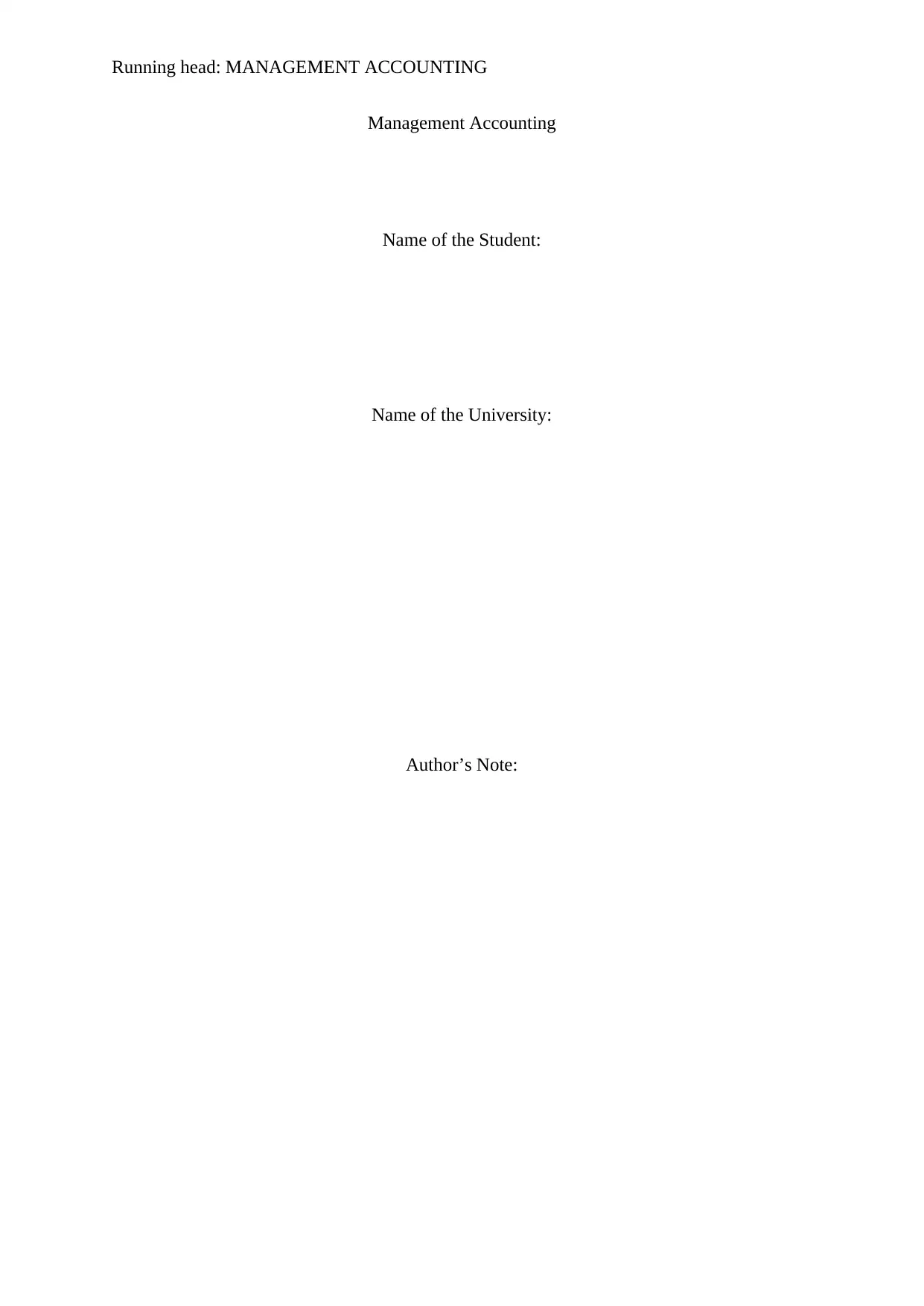
Running head: MANAGEMENT ACCOUNTING
Management Accounting
Name of the Student:
Name of the University:
Author’s Note:
Management Accounting
Name of the Student:
Name of the University:
Author’s Note:
Paraphrase This Document
Need a fresh take? Get an instant paraphrase of this document with our AI Paraphraser
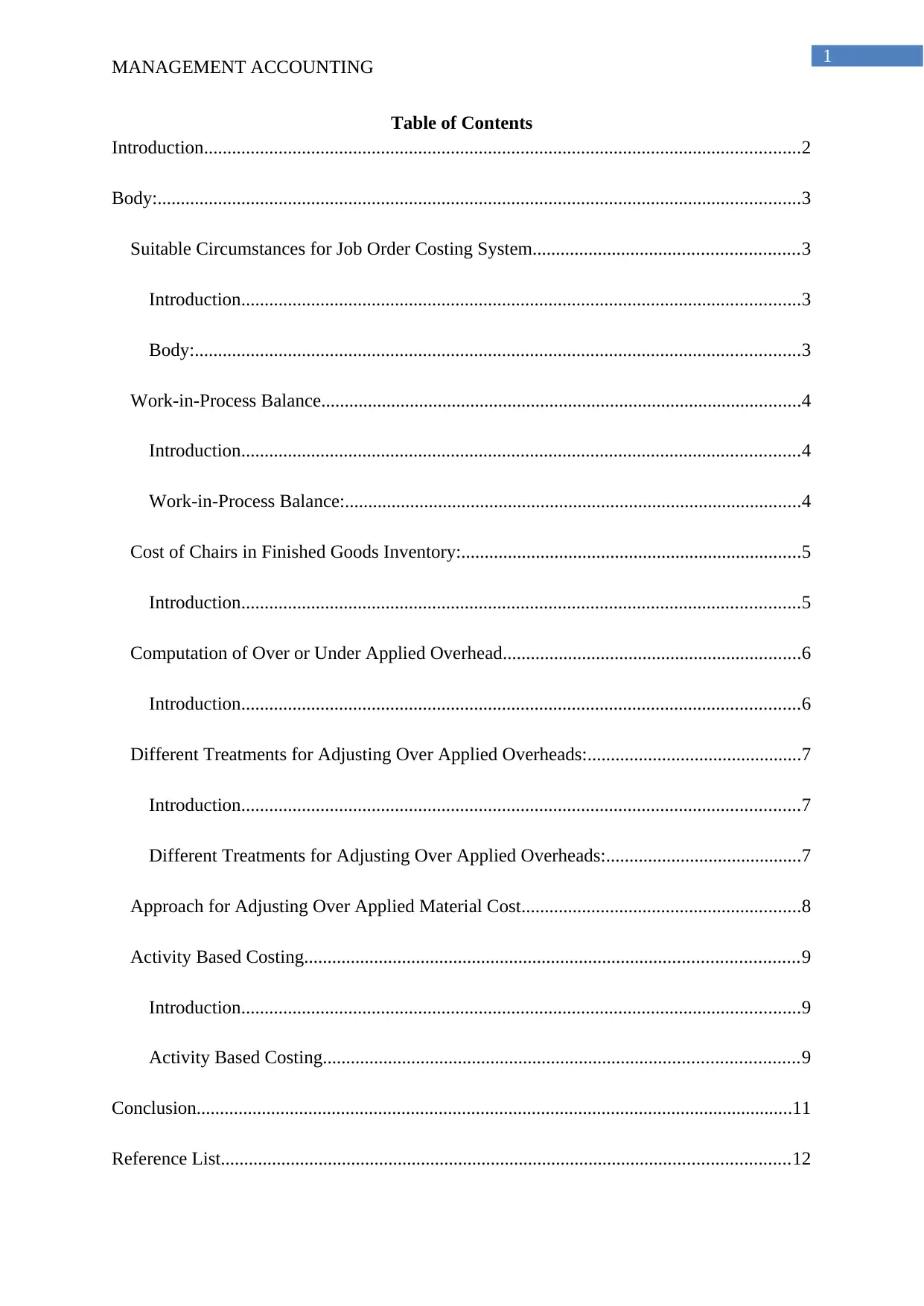
1
MANAGEMENT ACCOUNTING
Table of Contents
Introduction................................................................................................................................2
Body:..........................................................................................................................................3
Suitable Circumstances for Job Order Costing System.........................................................3
Introduction........................................................................................................................3
Body:..................................................................................................................................3
Work-in-Process Balance.......................................................................................................4
Introduction........................................................................................................................4
Work-in-Process Balance:..................................................................................................4
Cost of Chairs in Finished Goods Inventory:.........................................................................5
Introduction........................................................................................................................5
Computation of Over or Under Applied Overhead................................................................6
Introduction........................................................................................................................6
Different Treatments for Adjusting Over Applied Overheads:..............................................7
Introduction........................................................................................................................7
Different Treatments for Adjusting Over Applied Overheads:..........................................7
Approach for Adjusting Over Applied Material Cost............................................................8
Activity Based Costing..........................................................................................................9
Introduction........................................................................................................................9
Activity Based Costing......................................................................................................9
Conclusion................................................................................................................................11
Reference List..........................................................................................................................12
MANAGEMENT ACCOUNTING
Table of Contents
Introduction................................................................................................................................2
Body:..........................................................................................................................................3
Suitable Circumstances for Job Order Costing System.........................................................3
Introduction........................................................................................................................3
Body:..................................................................................................................................3
Work-in-Process Balance.......................................................................................................4
Introduction........................................................................................................................4
Work-in-Process Balance:..................................................................................................4
Cost of Chairs in Finished Goods Inventory:.........................................................................5
Introduction........................................................................................................................5
Computation of Over or Under Applied Overhead................................................................6
Introduction........................................................................................................................6
Different Treatments for Adjusting Over Applied Overheads:..............................................7
Introduction........................................................................................................................7
Different Treatments for Adjusting Over Applied Overheads:..........................................7
Approach for Adjusting Over Applied Material Cost............................................................8
Activity Based Costing..........................................................................................................9
Introduction........................................................................................................................9
Activity Based Costing......................................................................................................9
Conclusion................................................................................................................................11
Reference List..........................................................................................................................12
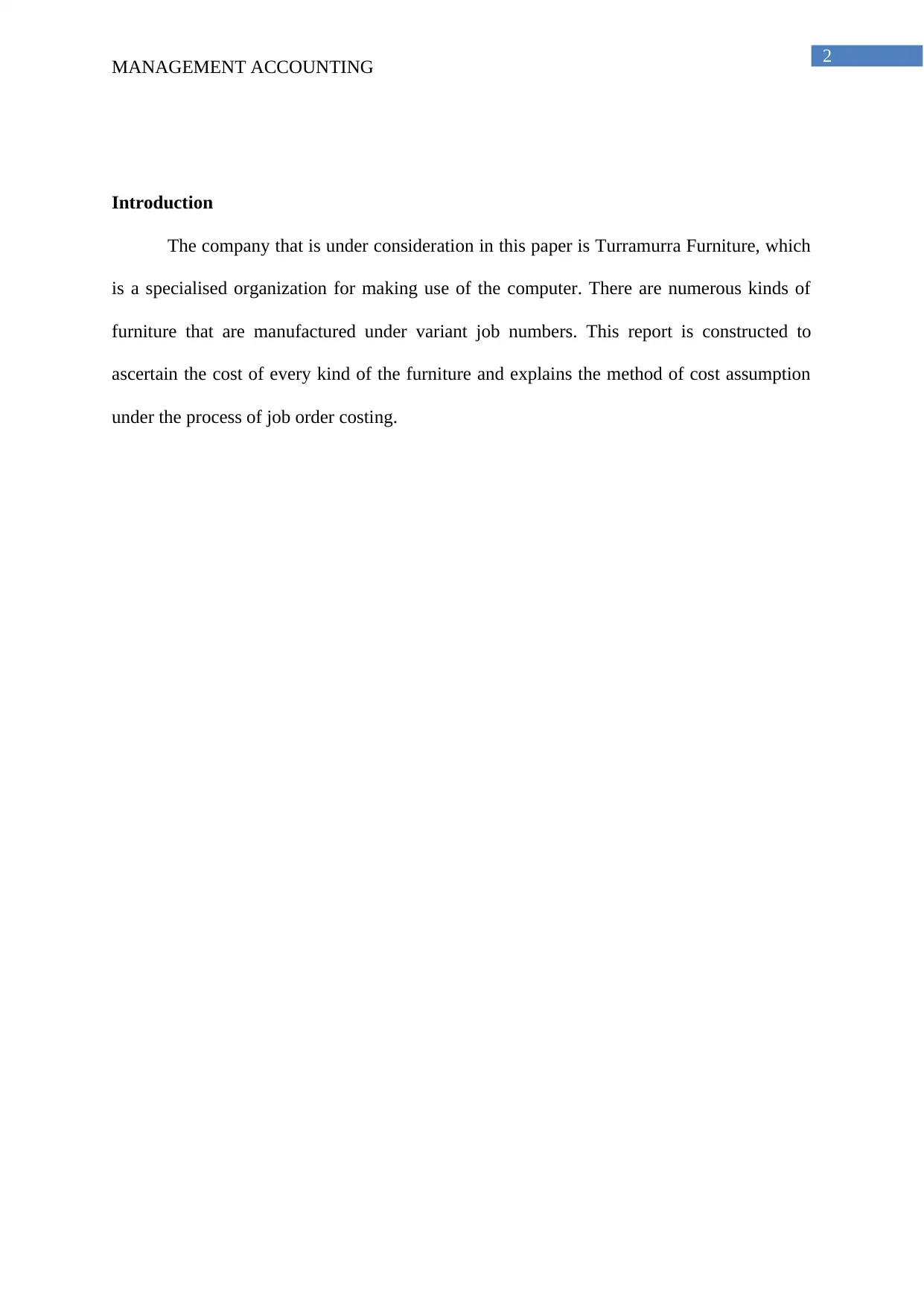
2
MANAGEMENT ACCOUNTING
Introduction
The company that is under consideration in this paper is Turramurra Furniture, which
is a specialised organization for making use of the computer. There are numerous kinds of
furniture that are manufactured under variant job numbers. This report is constructed to
ascertain the cost of every kind of the furniture and explains the method of cost assumption
under the process of job order costing.
MANAGEMENT ACCOUNTING
Introduction
The company that is under consideration in this paper is Turramurra Furniture, which
is a specialised organization for making use of the computer. There are numerous kinds of
furniture that are manufactured under variant job numbers. This report is constructed to
ascertain the cost of every kind of the furniture and explains the method of cost assumption
under the process of job order costing.
⊘ This is a preview!⊘
Do you want full access?
Subscribe today to unlock all pages.

Trusted by 1+ million students worldwide
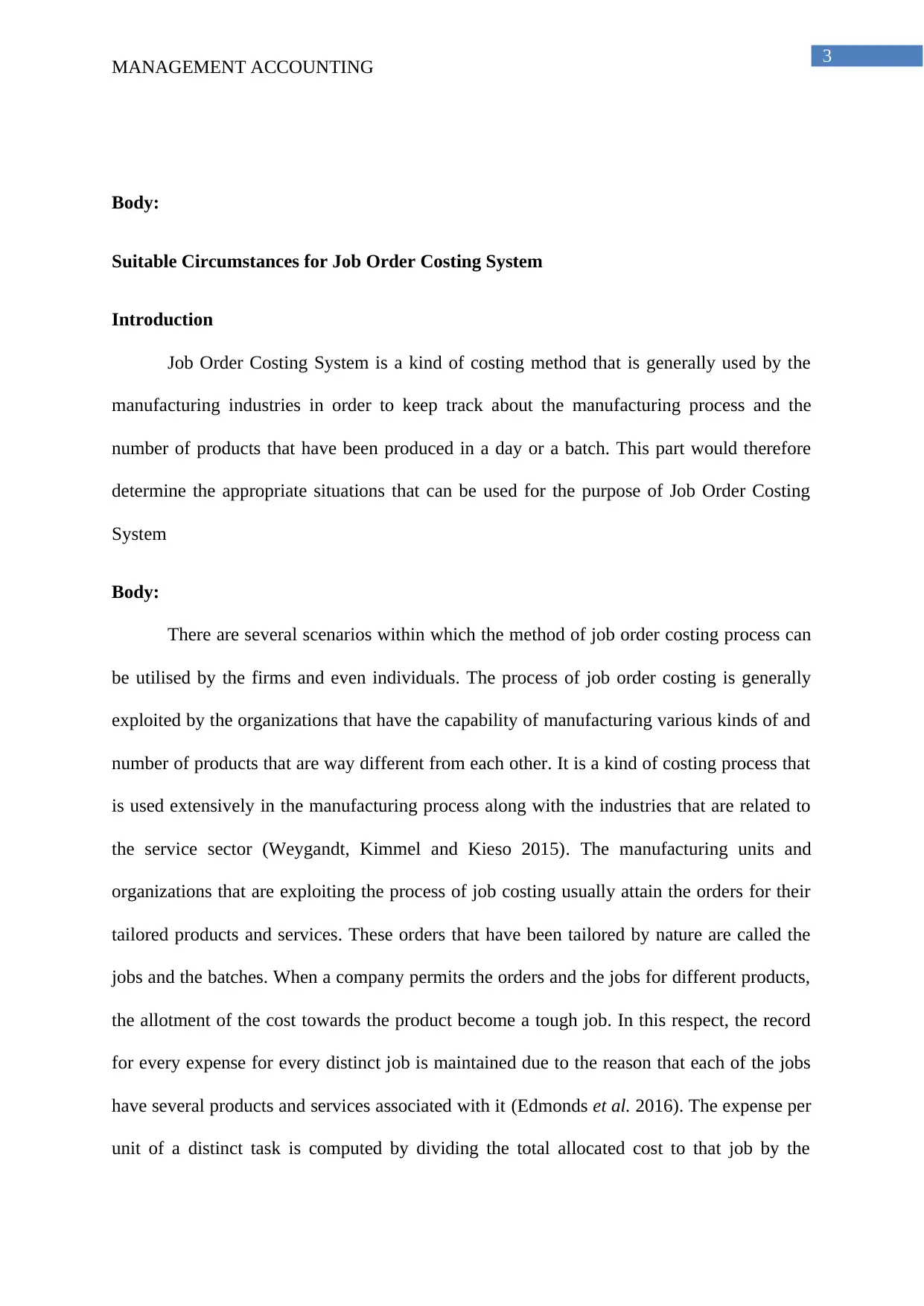
3
MANAGEMENT ACCOUNTING
Body:
Suitable Circumstances for Job Order Costing System
Introduction
Job Order Costing System is a kind of costing method that is generally used by the
manufacturing industries in order to keep track about the manufacturing process and the
number of products that have been produced in a day or a batch. This part would therefore
determine the appropriate situations that can be used for the purpose of Job Order Costing
System
Body:
There are several scenarios within which the method of job order costing process can
be utilised by the firms and even individuals. The process of job order costing is generally
exploited by the organizations that have the capability of manufacturing various kinds of and
number of products that are way different from each other. It is a kind of costing process that
is used extensively in the manufacturing process along with the industries that are related to
the service sector (Weygandt, Kimmel and Kieso 2015). The manufacturing units and
organizations that are exploiting the process of job costing usually attain the orders for their
tailored products and services. These orders that have been tailored by nature are called the
jobs and the batches. When a company permits the orders and the jobs for different products,
the allotment of the cost towards the product become a tough job. In this respect, the record
for every expense for every distinct job is maintained due to the reason that each of the jobs
have several products and services associated with it (Edmonds et al. 2016). The expense per
unit of a distinct task is computed by dividing the total allocated cost to that job by the
MANAGEMENT ACCOUNTING
Body:
Suitable Circumstances for Job Order Costing System
Introduction
Job Order Costing System is a kind of costing method that is generally used by the
manufacturing industries in order to keep track about the manufacturing process and the
number of products that have been produced in a day or a batch. This part would therefore
determine the appropriate situations that can be used for the purpose of Job Order Costing
System
Body:
There are several scenarios within which the method of job order costing process can
be utilised by the firms and even individuals. The process of job order costing is generally
exploited by the organizations that have the capability of manufacturing various kinds of and
number of products that are way different from each other. It is a kind of costing process that
is used extensively in the manufacturing process along with the industries that are related to
the service sector (Weygandt, Kimmel and Kieso 2015). The manufacturing units and
organizations that are exploiting the process of job costing usually attain the orders for their
tailored products and services. These orders that have been tailored by nature are called the
jobs and the batches. When a company permits the orders and the jobs for different products,
the allotment of the cost towards the product become a tough job. In this respect, the record
for every expense for every distinct job is maintained due to the reason that each of the jobs
have several products and services associated with it (Edmonds et al. 2016). The expense per
unit of a distinct task is computed by dividing the total allocated cost to that job by the
Paraphrase This Document
Need a fresh take? Get an instant paraphrase of this document with our AI Paraphraser
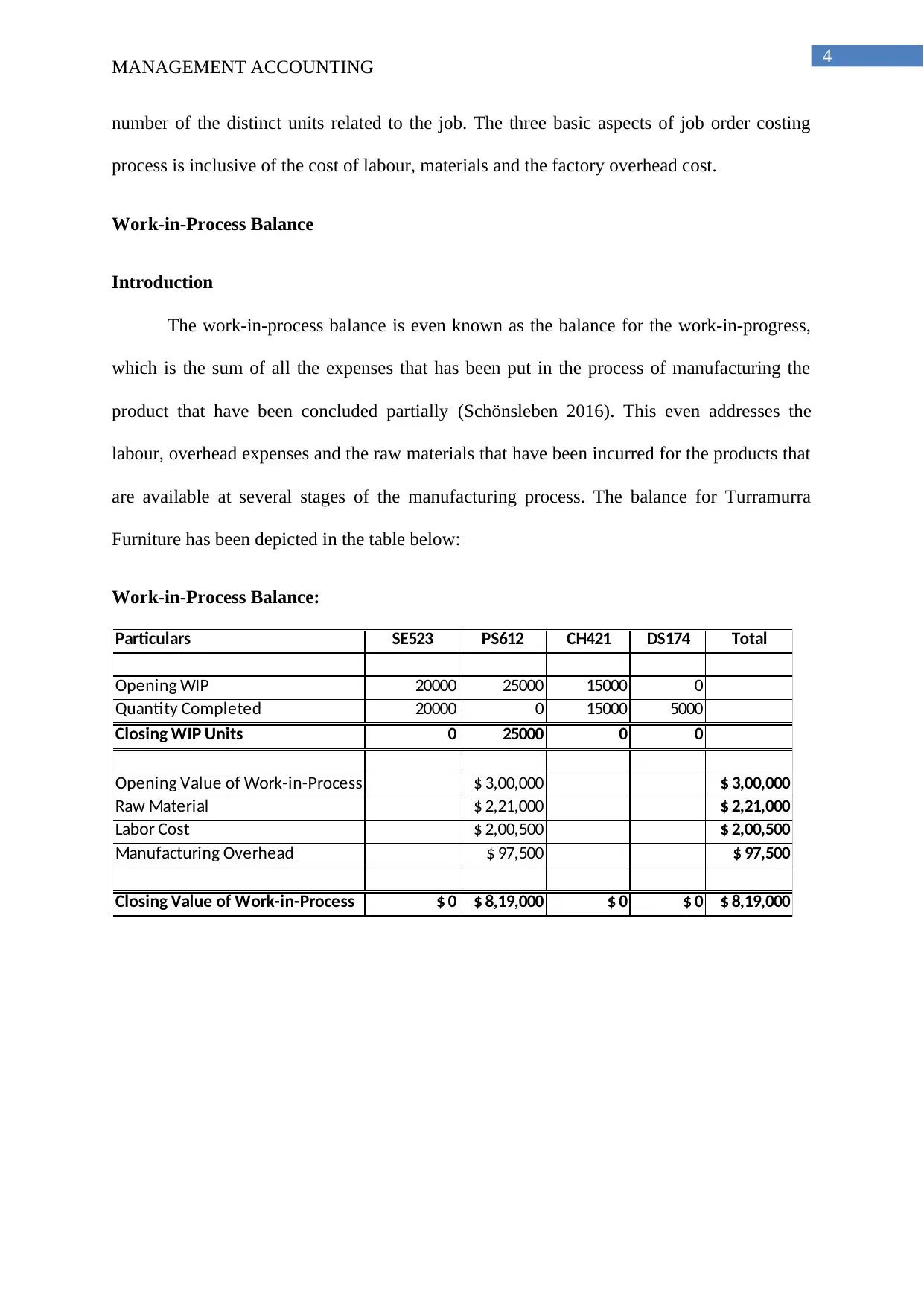
4
MANAGEMENT ACCOUNTING
number of the distinct units related to the job. The three basic aspects of job order costing
process is inclusive of the cost of labour, materials and the factory overhead cost.
Work-in-Process Balance
Introduction
The work-in-process balance is even known as the balance for the work-in-progress,
which is the sum of all the expenses that has been put in the process of manufacturing the
product that have been concluded partially (Schönsleben 2016). This even addresses the
labour, overhead expenses and the raw materials that have been incurred for the products that
are available at several stages of the manufacturing process. The balance for Turramurra
Furniture has been depicted in the table below:
Work-in-Process Balance:
Particulars SE523 PS612 CH421 DS174 Total
Opening WIP 20000 25000 15000 0
Quantity Completed 20000 0 15000 5000
Closing WIP Units 0 25000 0 0
Opening Value of Work-in-Process $ 3,00,000 $ 3,00,000
Raw Material $ 2,21,000 $ 2,21,000
Labor Cost $ 2,00,500 $ 2,00,500
Manufacturing Overhead $ 97,500 $ 97,500
Closing Value of Work-in-Process $ 0 $ 8,19,000 $ 0 $ 0 $ 8,19,000
MANAGEMENT ACCOUNTING
number of the distinct units related to the job. The three basic aspects of job order costing
process is inclusive of the cost of labour, materials and the factory overhead cost.
Work-in-Process Balance
Introduction
The work-in-process balance is even known as the balance for the work-in-progress,
which is the sum of all the expenses that has been put in the process of manufacturing the
product that have been concluded partially (Schönsleben 2016). This even addresses the
labour, overhead expenses and the raw materials that have been incurred for the products that
are available at several stages of the manufacturing process. The balance for Turramurra
Furniture has been depicted in the table below:
Work-in-Process Balance:
Particulars SE523 PS612 CH421 DS174 Total
Opening WIP 20000 25000 15000 0
Quantity Completed 20000 0 15000 5000
Closing WIP Units 0 25000 0 0
Opening Value of Work-in-Process $ 3,00,000 $ 3,00,000
Raw Material $ 2,21,000 $ 2,21,000
Labor Cost $ 2,00,500 $ 2,00,500
Manufacturing Overhead $ 97,500 $ 97,500
Closing Value of Work-in-Process $ 0 $ 8,19,000 $ 0 $ 0 $ 8,19,000
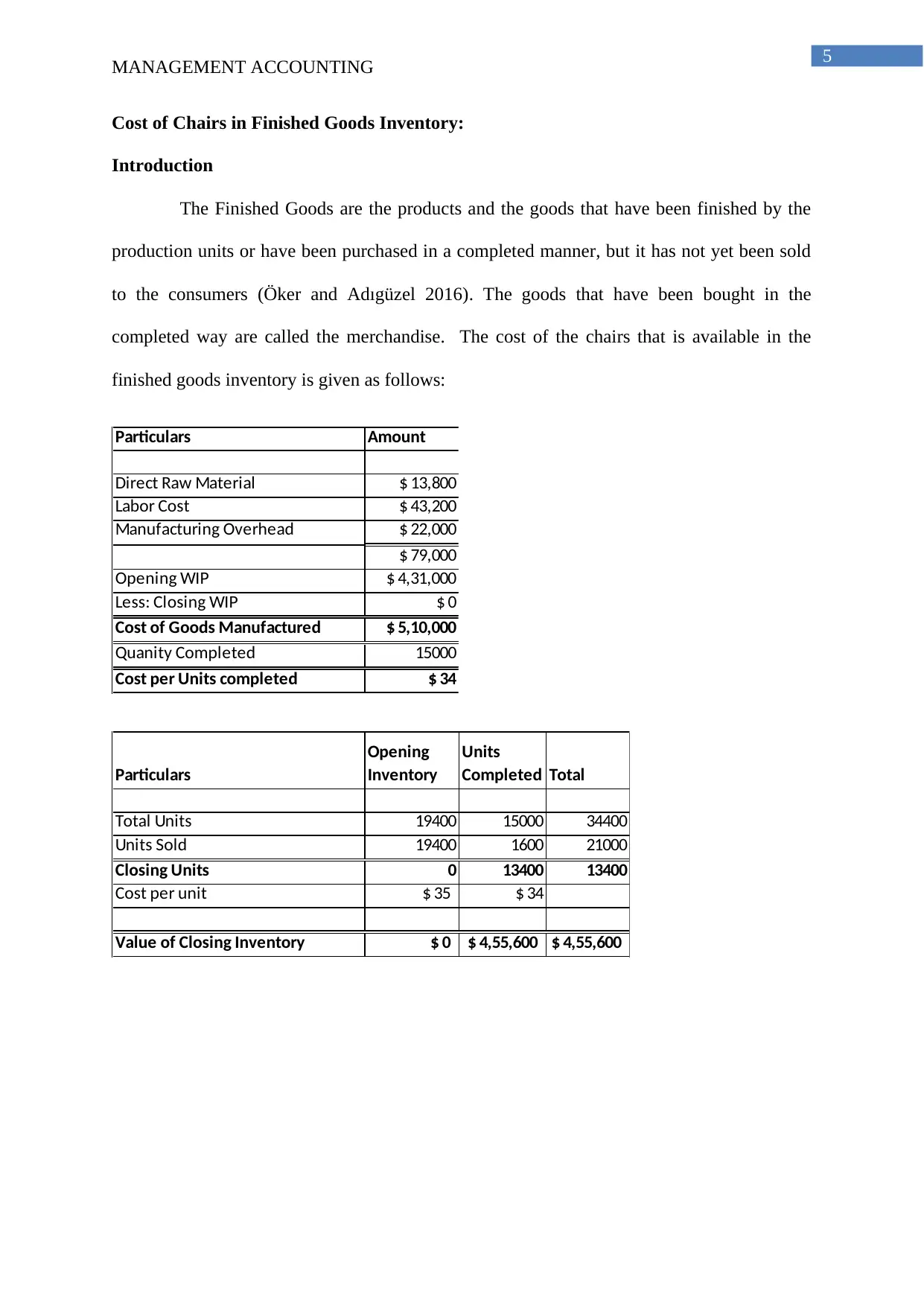
5
MANAGEMENT ACCOUNTING
Cost of Chairs in Finished Goods Inventory:
Introduction
The Finished Goods are the products and the goods that have been finished by the
production units or have been purchased in a completed manner, but it has not yet been sold
to the consumers (Öker and Adıgüzel 2016). The goods that have been bought in the
completed way are called the merchandise. The cost of the chairs that is available in the
finished goods inventory is given as follows:
Particulars Amount
Direct Raw Material $ 13,800
Labor Cost $ 43,200
Manufacturing Overhead $ 22,000
$ 79,000
Opening WIP $ 4,31,000
Less: Closing WIP $ 0
Cost of Goods Manufactured $ 5,10,000
Quanity Completed 15000
Cost per Units completed $ 34
Particulars
Opening
Inventory
Units
Completed Total
Total Units 19400 15000 34400
Units Sold 19400 1600 21000
Closing Units 0 13400 13400
Cost per unit $ 35 $ 34
Value of Closing Inventory $ 0 $ 4,55,600 $ 4,55,600
MANAGEMENT ACCOUNTING
Cost of Chairs in Finished Goods Inventory:
Introduction
The Finished Goods are the products and the goods that have been finished by the
production units or have been purchased in a completed manner, but it has not yet been sold
to the consumers (Öker and Adıgüzel 2016). The goods that have been bought in the
completed way are called the merchandise. The cost of the chairs that is available in the
finished goods inventory is given as follows:
Particulars Amount
Direct Raw Material $ 13,800
Labor Cost $ 43,200
Manufacturing Overhead $ 22,000
$ 79,000
Opening WIP $ 4,31,000
Less: Closing WIP $ 0
Cost of Goods Manufactured $ 5,10,000
Quanity Completed 15000
Cost per Units completed $ 34
Particulars
Opening
Inventory
Units
Completed Total
Total Units 19400 15000 34400
Units Sold 19400 1600 21000
Closing Units 0 13400 13400
Cost per unit $ 35 $ 34
Value of Closing Inventory $ 0 $ 4,55,600 $ 4,55,600
⊘ This is a preview!⊘
Do you want full access?
Subscribe today to unlock all pages.

Trusted by 1+ million students worldwide
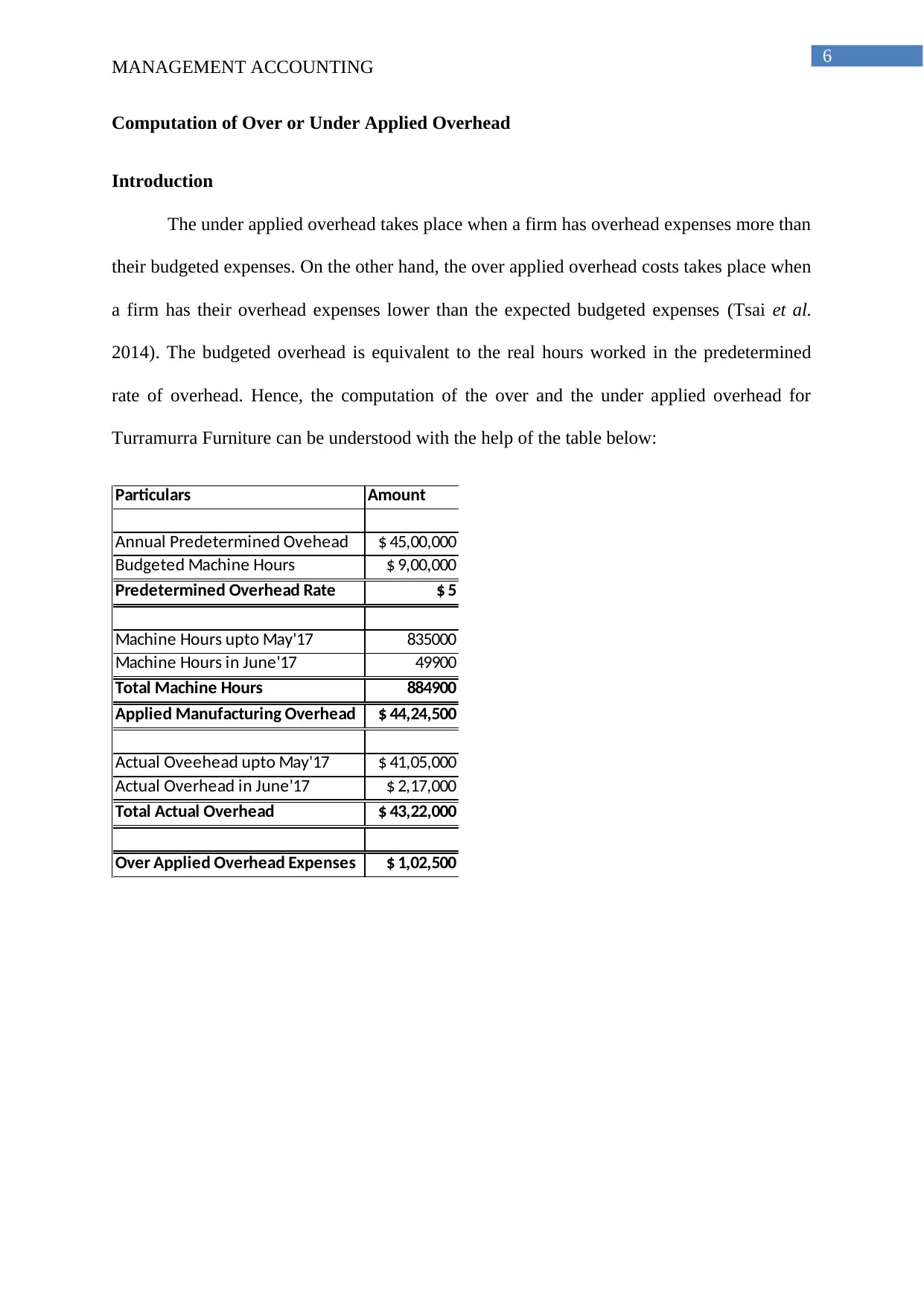
6
MANAGEMENT ACCOUNTING
Computation of Over or Under Applied Overhead
Introduction
The under applied overhead takes place when a firm has overhead expenses more than
their budgeted expenses. On the other hand, the over applied overhead costs takes place when
a firm has their overhead expenses lower than the expected budgeted expenses (Tsai et al.
2014). The budgeted overhead is equivalent to the real hours worked in the predetermined
rate of overhead. Hence, the computation of the over and the under applied overhead for
Turramurra Furniture can be understood with the help of the table below:
Particulars Amount
Annual Predetermined Ovehead $ 45,00,000
Budgeted Machine Hours $ 9,00,000
Predetermined Overhead Rate $ 5
Machine Hours upto May'17 835000
Machine Hours in June'17 49900
Total Machine Hours 884900
Applied Manufacturing Overhead $ 44,24,500
Actual Oveehead upto May'17 $ 41,05,000
Actual Overhead in June'17 $ 2,17,000
Total Actual Overhead $ 43,22,000
Over Applied Overhead Expenses $ 1,02,500
MANAGEMENT ACCOUNTING
Computation of Over or Under Applied Overhead
Introduction
The under applied overhead takes place when a firm has overhead expenses more than
their budgeted expenses. On the other hand, the over applied overhead costs takes place when
a firm has their overhead expenses lower than the expected budgeted expenses (Tsai et al.
2014). The budgeted overhead is equivalent to the real hours worked in the predetermined
rate of overhead. Hence, the computation of the over and the under applied overhead for
Turramurra Furniture can be understood with the help of the table below:
Particulars Amount
Annual Predetermined Ovehead $ 45,00,000
Budgeted Machine Hours $ 9,00,000
Predetermined Overhead Rate $ 5
Machine Hours upto May'17 835000
Machine Hours in June'17 49900
Total Machine Hours 884900
Applied Manufacturing Overhead $ 44,24,500
Actual Oveehead upto May'17 $ 41,05,000
Actual Overhead in June'17 $ 2,17,000
Total Actual Overhead $ 43,22,000
Over Applied Overhead Expenses $ 1,02,500
Paraphrase This Document
Need a fresh take? Get an instant paraphrase of this document with our AI Paraphraser
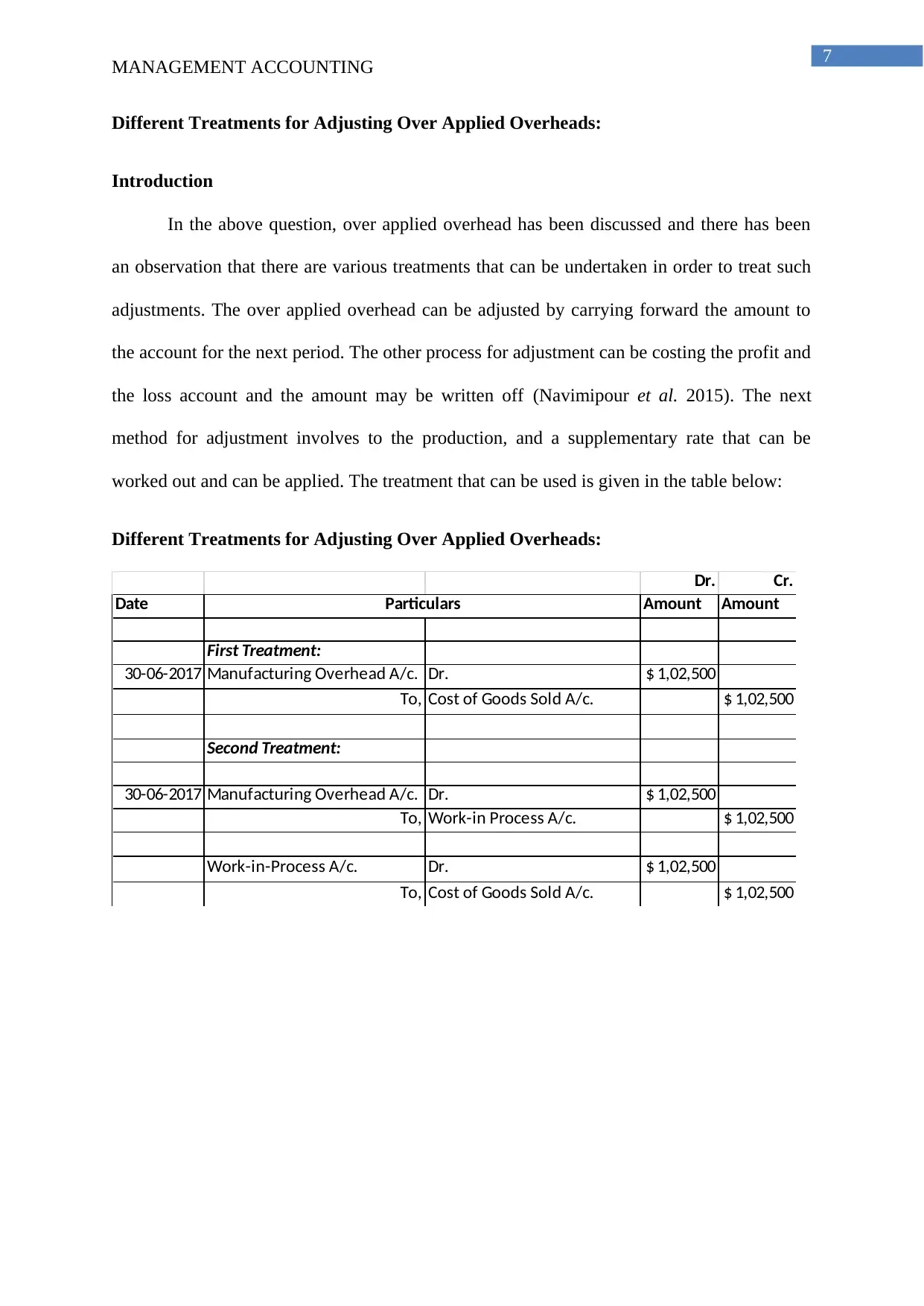
7
MANAGEMENT ACCOUNTING
Different Treatments for Adjusting Over Applied Overheads:
Introduction
In the above question, over applied overhead has been discussed and there has been
an observation that there are various treatments that can be undertaken in order to treat such
adjustments. The over applied overhead can be adjusted by carrying forward the amount to
the account for the next period. The other process for adjustment can be costing the profit and
the loss account and the amount may be written off (Navimipour et al. 2015). The next
method for adjustment involves to the production, and a supplementary rate that can be
worked out and can be applied. The treatment that can be used is given in the table below:
Different Treatments for Adjusting Over Applied Overheads:
Dr. Cr.
Date Amount Amount
First Treatment:
30-06-2017 Manufacturing Overhead A/c. Dr. $ 1,02,500
To, Cost of Goods Sold A/c. $ 1,02,500
Second Treatment:
30-06-2017 Manufacturing Overhead A/c. Dr. $ 1,02,500
To, Work-in Process A/c. $ 1,02,500
Work-in-Process A/c. Dr. $ 1,02,500
To, Cost of Goods Sold A/c. $ 1,02,500
Particulars
MANAGEMENT ACCOUNTING
Different Treatments for Adjusting Over Applied Overheads:
Introduction
In the above question, over applied overhead has been discussed and there has been
an observation that there are various treatments that can be undertaken in order to treat such
adjustments. The over applied overhead can be adjusted by carrying forward the amount to
the account for the next period. The other process for adjustment can be costing the profit and
the loss account and the amount may be written off (Navimipour et al. 2015). The next
method for adjustment involves to the production, and a supplementary rate that can be
worked out and can be applied. The treatment that can be used is given in the table below:
Different Treatments for Adjusting Over Applied Overheads:
Dr. Cr.
Date Amount Amount
First Treatment:
30-06-2017 Manufacturing Overhead A/c. Dr. $ 1,02,500
To, Cost of Goods Sold A/c. $ 1,02,500
Second Treatment:
30-06-2017 Manufacturing Overhead A/c. Dr. $ 1,02,500
To, Work-in Process A/c. $ 1,02,500
Work-in-Process A/c. Dr. $ 1,02,500
To, Cost of Goods Sold A/c. $ 1,02,500
Particulars
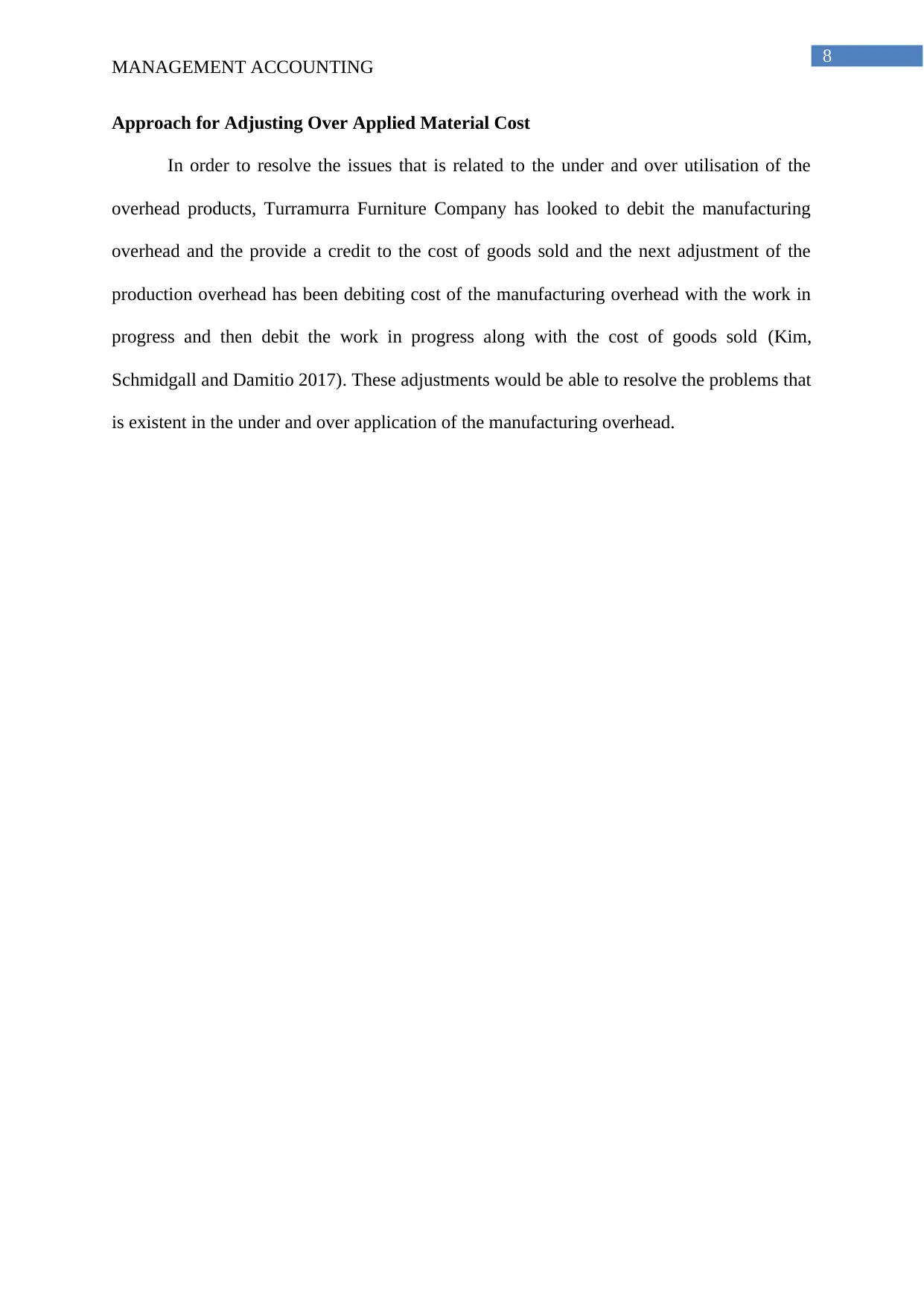
8
MANAGEMENT ACCOUNTING
Approach for Adjusting Over Applied Material Cost
In order to resolve the issues that is related to the under and over utilisation of the
overhead products, Turramurra Furniture Company has looked to debit the manufacturing
overhead and the provide a credit to the cost of goods sold and the next adjustment of the
production overhead has been debiting cost of the manufacturing overhead with the work in
progress and then debit the work in progress along with the cost of goods sold (Kim,
Schmidgall and Damitio 2017). These adjustments would be able to resolve the problems that
is existent in the under and over application of the manufacturing overhead.
MANAGEMENT ACCOUNTING
Approach for Adjusting Over Applied Material Cost
In order to resolve the issues that is related to the under and over utilisation of the
overhead products, Turramurra Furniture Company has looked to debit the manufacturing
overhead and the provide a credit to the cost of goods sold and the next adjustment of the
production overhead has been debiting cost of the manufacturing overhead with the work in
progress and then debit the work in progress along with the cost of goods sold (Kim,
Schmidgall and Damitio 2017). These adjustments would be able to resolve the problems that
is existent in the under and over application of the manufacturing overhead.
⊘ This is a preview!⊘
Do you want full access?
Subscribe today to unlock all pages.

Trusted by 1+ million students worldwide
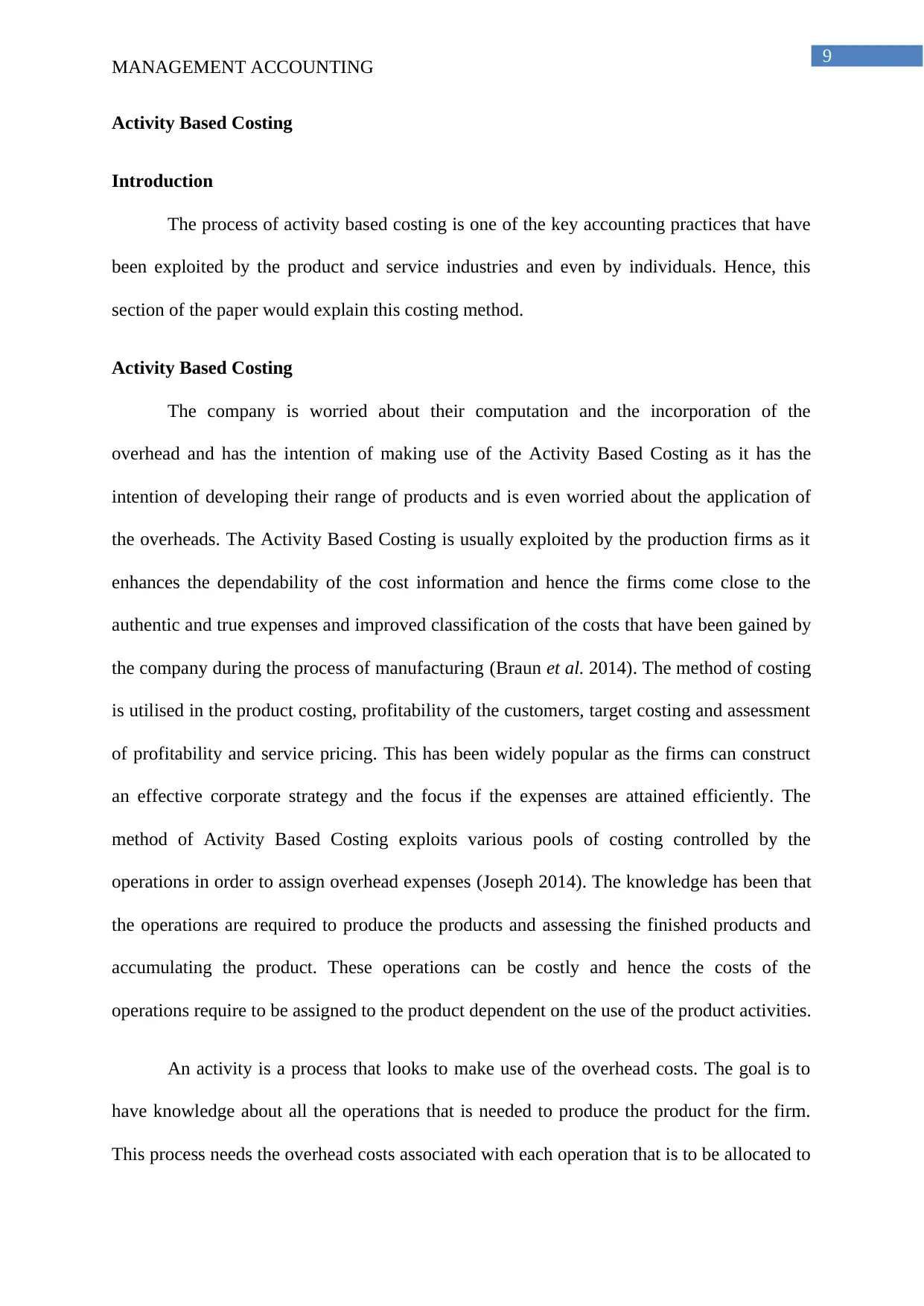
9
MANAGEMENT ACCOUNTING
Activity Based Costing
Introduction
The process of activity based costing is one of the key accounting practices that have
been exploited by the product and service industries and even by individuals. Hence, this
section of the paper would explain this costing method.
Activity Based Costing
The company is worried about their computation and the incorporation of the
overhead and has the intention of making use of the Activity Based Costing as it has the
intention of developing their range of products and is even worried about the application of
the overheads. The Activity Based Costing is usually exploited by the production firms as it
enhances the dependability of the cost information and hence the firms come close to the
authentic and true expenses and improved classification of the costs that have been gained by
the company during the process of manufacturing (Braun et al. 2014). The method of costing
is utilised in the product costing, profitability of the customers, target costing and assessment
of profitability and service pricing. This has been widely popular as the firms can construct
an effective corporate strategy and the focus if the expenses are attained efficiently. The
method of Activity Based Costing exploits various pools of costing controlled by the
operations in order to assign overhead expenses (Joseph 2014). The knowledge has been that
the operations are required to produce the products and assessing the finished products and
accumulating the product. These operations can be costly and hence the costs of the
operations require to be assigned to the product dependent on the use of the product activities.
An activity is a process that looks to make use of the overhead costs. The goal is to
have knowledge about all the operations that is needed to produce the product for the firm.
This process needs the overhead costs associated with each operation that is to be allocated to
MANAGEMENT ACCOUNTING
Activity Based Costing
Introduction
The process of activity based costing is one of the key accounting practices that have
been exploited by the product and service industries and even by individuals. Hence, this
section of the paper would explain this costing method.
Activity Based Costing
The company is worried about their computation and the incorporation of the
overhead and has the intention of making use of the Activity Based Costing as it has the
intention of developing their range of products and is even worried about the application of
the overheads. The Activity Based Costing is usually exploited by the production firms as it
enhances the dependability of the cost information and hence the firms come close to the
authentic and true expenses and improved classification of the costs that have been gained by
the company during the process of manufacturing (Braun et al. 2014). The method of costing
is utilised in the product costing, profitability of the customers, target costing and assessment
of profitability and service pricing. This has been widely popular as the firms can construct
an effective corporate strategy and the focus if the expenses are attained efficiently. The
method of Activity Based Costing exploits various pools of costing controlled by the
operations in order to assign overhead expenses (Joseph 2014). The knowledge has been that
the operations are required to produce the products and assessing the finished products and
accumulating the product. These operations can be costly and hence the costs of the
operations require to be assigned to the product dependent on the use of the product activities.
An activity is a process that looks to make use of the overhead costs. The goal is to
have knowledge about all the operations that is needed to produce the product for the firm.
This process needs the overhead costs associated with each operation that is to be allocated to
Paraphrase This Document
Need a fresh take? Get an instant paraphrase of this document with our AI Paraphraser
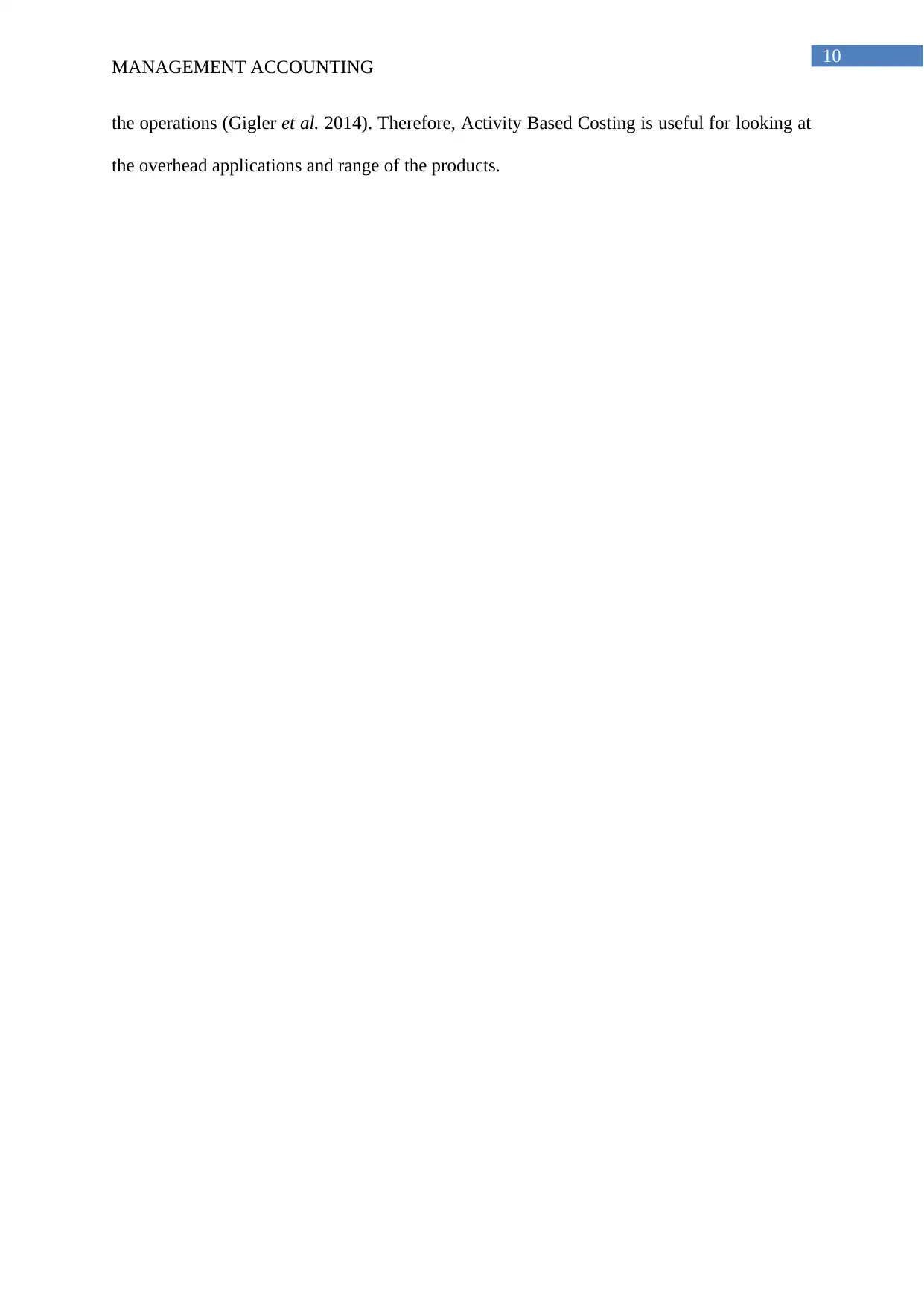
10
MANAGEMENT ACCOUNTING
the operations (Gigler et al. 2014). Therefore, Activity Based Costing is useful for looking at
the overhead applications and range of the products.
MANAGEMENT ACCOUNTING
the operations (Gigler et al. 2014). Therefore, Activity Based Costing is useful for looking at
the overhead applications and range of the products.
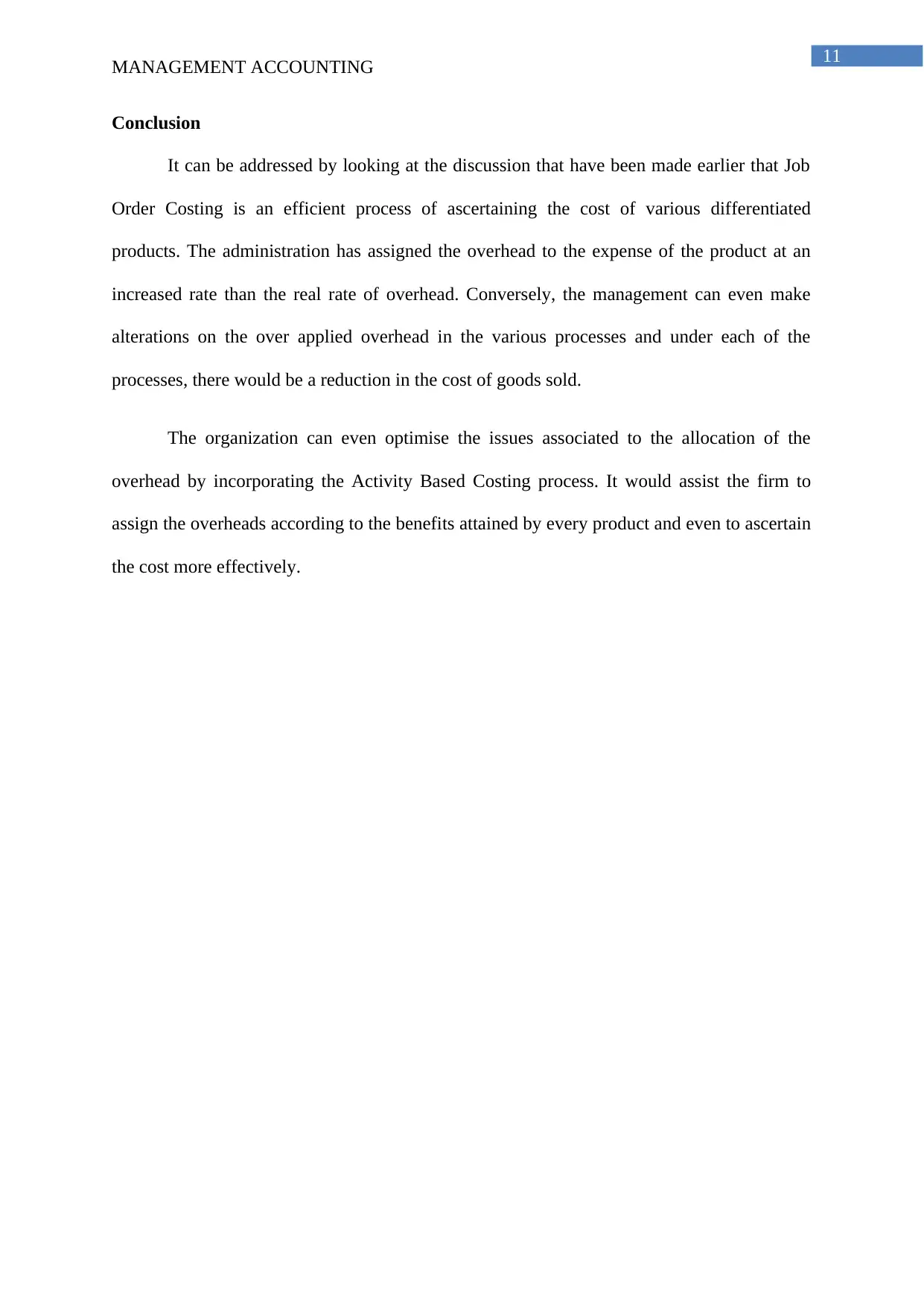
11
MANAGEMENT ACCOUNTING
Conclusion
It can be addressed by looking at the discussion that have been made earlier that Job
Order Costing is an efficient process of ascertaining the cost of various differentiated
products. The administration has assigned the overhead to the expense of the product at an
increased rate than the real rate of overhead. Conversely, the management can even make
alterations on the over applied overhead in the various processes and under each of the
processes, there would be a reduction in the cost of goods sold.
The organization can even optimise the issues associated to the allocation of the
overhead by incorporating the Activity Based Costing process. It would assist the firm to
assign the overheads according to the benefits attained by every product and even to ascertain
the cost more effectively.
MANAGEMENT ACCOUNTING
Conclusion
It can be addressed by looking at the discussion that have been made earlier that Job
Order Costing is an efficient process of ascertaining the cost of various differentiated
products. The administration has assigned the overhead to the expense of the product at an
increased rate than the real rate of overhead. Conversely, the management can even make
alterations on the over applied overhead in the various processes and under each of the
processes, there would be a reduction in the cost of goods sold.
The organization can even optimise the issues associated to the allocation of the
overhead by incorporating the Activity Based Costing process. It would assist the firm to
assign the overheads according to the benefits attained by every product and even to ascertain
the cost more effectively.
⊘ This is a preview!⊘
Do you want full access?
Subscribe today to unlock all pages.

Trusted by 1+ million students worldwide
1 out of 14
Related Documents
Your All-in-One AI-Powered Toolkit for Academic Success.
+13062052269
info@desklib.com
Available 24*7 on WhatsApp / Email
![[object Object]](/_next/static/media/star-bottom.7253800d.svg)
Unlock your academic potential
Copyright © 2020–2025 A2Z Services. All Rights Reserved. Developed and managed by ZUCOL.





